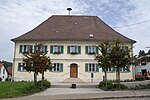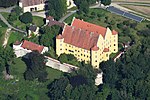Turritellenplatte
The Turritellenplatte of Ermingen ("Erminger Turritellenplatte" near Ulm, Germany) is a type of very rich, fossil-bearing rock which is of particular interest to geologists and paleontologists. It occurs in a very restricted outcrop and is protected in its entirety as a natural monument. This outcrop of these marine sedimentary rocks is situated in the northern part of the North Alpine Foreland Basin (NAFB) and it is famous for a superabundance of shells of the sea snail Turritella turris, a marine gastropod mollusk in the family Turritellidae. The fauna of this gastropod-rich sandstone reflects mainly near-coastal and shallow marine conditions. Petrographical and palaeontological data allow a correlation of the Turritellenplatte of Ermingen with Burdigalian (Lower Miocene). The Sr-isotope composition of shark teeth in the deposit suggests an age of about 18.5 million years for the Turritellenplatte of Ermingen.
Excerpt from the Wikipedia article Turritellenplatte (License: CC BY-SA 3.0, Authors).Turritellenplatte
Arnegger Straße, Ulm
Geographical coordinates (GPS) Address Nearby Places Show on map
Geographical coordinates (GPS)
| Latitude | Longitude |
|---|---|
| N 48.389 ° | E 9.893 ° |
Address
Arnegger Straße
89081 Ulm (Ermingen)
Baden-Württemberg, Germany
Open on Google Maps








